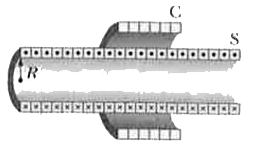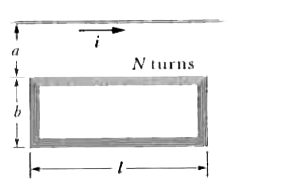A coil C of N turns is placed around a long solenoid S of radius R and n turns per unit length, as in Fig. 30-38.
(a) Show that the mutual inductance for the coil-solenoid combination is given by M=μ0πR2nN.
(b) Explain why M does not depend on the shape, size, or possible lack of close packing of the coil.

Step by step video & image solution for A coil C of N turns is placed around a long solenoid S of radius R and n turns per unit length, as in Fig. 30-38. (a) Show that the mutual inductance for the coil-solenoid combination is given by M = μ_(0)piR^(2)nN. (b) Explain why M does not depend on the shape, size, or possible lack of close packing of the coil. by Physics experts to help you in doubts & scoring excellent marks in Class 12 exams.
Updated on:21/07/2023Topper's Solved these Questions
- ELECTROMAGNETIC INDUCTIONBOOK - RESNICK AND HALLIDAYCHAPTER - ELECTROMAGNETIC INDUCTIONEXERCISE - PRACTICE QUESTIONS (Single Correct Choice Type)
45 Videos
- ELECTROMAGNETIC INDUCTIONBOOK - RESNICK AND HALLIDAYCHAPTER - ELECTROMAGNETIC INDUCTIONEXERCISE - PRACTICE QUESTIONS (More than One Correct Choice Type)
13 Videos
- ELECTROMAGNETIC INDUCTIONBOOK - RESNICK AND HALLIDAYCHAPTER - ELECTROMAGNETIC INDUCTIONEXERCISE - CHECKPOINTS
9 Videos
- ELECTRIC POTENTIALBOOK - RESNICK AND HALLIDAYCHAPTER - ELECTRIC POTENTIALEXERCISE - (PRACTICE QUESTIONS) Integer Type
1 Videos
- ELECTROMAGNETIC OSCILLATIONS AND ALTERNATING CURRENT BOOK - RESNICK AND HALLIDAYCHAPTER - ELECTROMAGNETIC OSCILLATIONS AND ALTERNATING CURRENT EXERCISE - Practice Questions (Integer)
7 Videos
Similar Questions
A rectangular loop of N closely packed turns is positioned near a long straight wire as shown in Fig. 30-40. What is the mutual inductance M for the loop-wire combination if N = 150, a = 1.0 cm, b = 9.5 cm, and l = 30 cm?

View SolutionA solenoid is of length 50cm and has a radius of 2cm. It has 500 turns. Around its central section a coil of 50 turns is wound. Calculate the mutual inductance of the system.
View Solution
Knowledge Check
A conducting ring of radius b is placed coaxially in a long solenoid of radius a (b < a) having n turns per unit length. A current i=i0, cosωt flows through the solenoid. The induced emf in the ring is
AZeroBμ0ni0πa2ωCμ0ni0πa2cosωtDμ0ni0πb2ωcosωtA circular coil of radius a and having N turns is placed at centre of a long solenoid, coaxially. The solenoid has radius b (b>>a) and number of turns per unit length is n. Their coefficient of mutual inductance will be -
Aμ0nN2πa2Bμ0nNπa2Cμ0n2Nπa2Dμ0n2N2πa2A long solenoid of length L, cross section A having N1 turns has about its center a small coil of N2 turns as shows in Fig The mutual inductance of two circuits is
 Aμ0A(N1/N2)LBμ0A(N1N2)LCμ0AN1N2LDμ0AN21N2L
Aμ0A(N1/N2)LBμ0A(N1N2)LCμ0AN1N2LDμ0AN21N2L
The current in a long solenoid of radius R and having n turns per unit length is given by i=i0sinωt. A coil having N turns is wound around it near the centre. Find (a) the induced emf in the coil and (b) the mutual inductance between the solenoid and the coil.
View SolutionA very long straight solenoid has a cross section radius R. A number of turns per unit length is equal to n. Find the magnetic induction at the centre of the coil when a current I flows thougth it.
View SolutionA 2 m long solenoid with diameter 4 cm and 2000 turns has a secondary of 1000 turns wound closely near its mid point. Calculate the mutual inductance between the two coils.
View SolutionA long solcnoid of length 1m, cross-sectional area 10cm2, having 1000 turns has wound about its centre a small coil of 20 turns. Compute the mutual inductance of the pair of solenoid and the coil . What is the induced EMF in the coil when the current in the solenoid changes at the rate of 10A/s?
View SolutionA srot soleniod of radius a, number of turns per unit length n2, and length L is kept coaxially inside a very long solenoid of radius b, number of turns per unit length n2. What is the mutual inductance of the system?
View Solution
